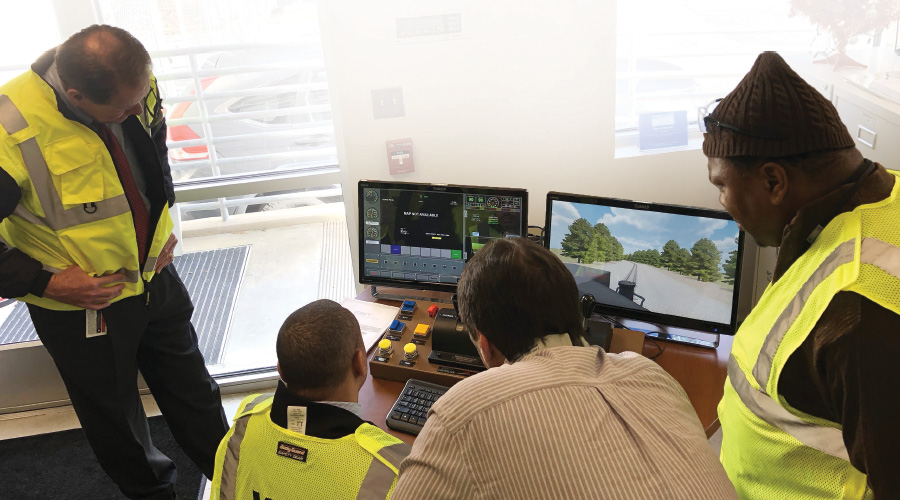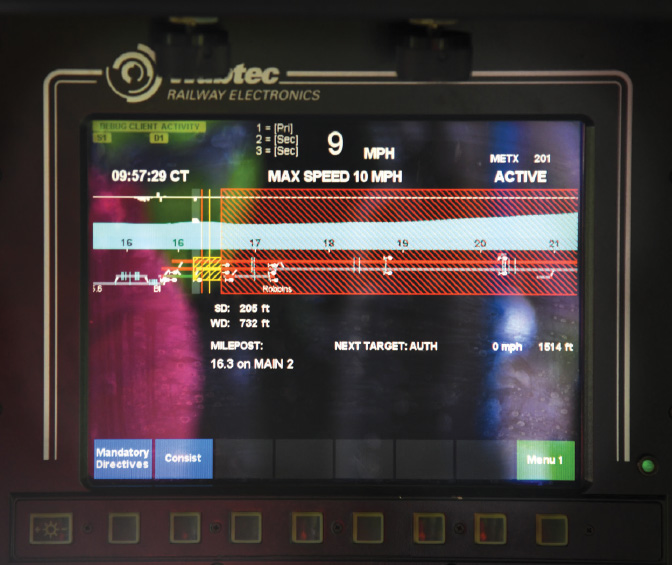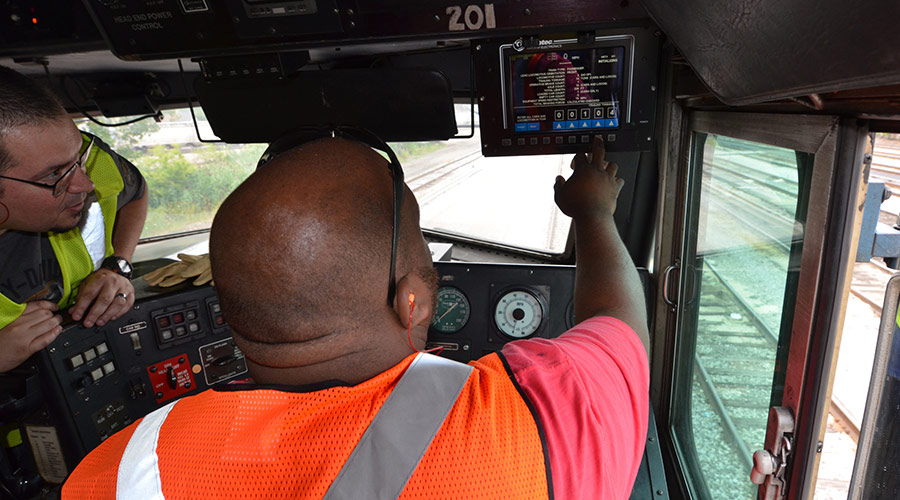Stay updated on news, articles and information for the rail industry
June 2019
Rail News: PTC
PTC progress report 2019: Commuter railroads

By Michael Popke
In terms of reaching the positive train control (PTC) finish line, Christmas came early last year for Port Authority Trans-Hudson Corp. (PATH). In early December, the agency became one of the first commuter railroads to complete PTC implementation and obtain system certification from the Federal Railroad Administration (FRA).
PATH — which operates between large metropolitan areas in northern New Jersey and Manhattan — marked that achievement about three weeks before the federal end-of-2018 deadline.
The agency joined Metrolink, the North County Transit District and Portland & Western Railroad as the only four railroads that finished implementation prior to the deadline. The other three dozen freight and commuter railroads impacted by the federal mandate met six criteria to obtain a two-year extension to 2020’s end, such as by equipping all required route miles with PTC.
Meeting the end-of-2018 deadline with time to spare was quite the accomplishment for PATH because implementation was a struggle earlier last year, says Clarelle DeGraffe, who was appointed director of rail transit and general manager in March 2019. Intricately involved with the PTC project as deputy director prior to the promotion, DeGraffe sensed PATH employees were getting taxed by the long and exhausting implementation process, but the finish line was in sight.
“We’d been pushing for years, putting our best foot forward. There were times when the task just looked so daunting, and we had to give each other pep talks,” she says. “But we were not putting in for an extension. That was not an option for us.”
However, PTC is just part of a more comprehensive system PATH is adopting to enhance safety and operations. The agency is replacing a fixed-block system with communications-based train control — which is designed to calculate a train’s exact position, speed, travel direction and safe braking distance — so trains can run more frequently and closer together.
In the meantime, other commuter railroads aim to continue chipping away at their PTC projects this year and next, including MTA Metro-North Railroad (MNR) and MTA Long Island Rail Road (LIRR) in the New York City region; Virginia Railway Express (VRE) in the Washington, D.C., vicinity; Metra in the Chicago metroplex; and the Denton County Transportation Authority (DCTA) in the greater Dallas area.
Based on interviews with officials from those agencies, they’re making significant strides, spending the extra time allotted by the deadline extension to continue system testing and certification work, and achieving interoperability with other railroads.
Cooperation and determination
For VRE, working collaboratively with host railroads Norfolk Southern Railway and CSX is key to furthering implementation, which is expected to cost about $15 million. In April, the agency declared PTC was fully operational on all of its 32 inbound and outbound trains on the Fredericksburg and Manassas lines, an achievement that required close cooperation with the Class Is.
“We now have an opportunity to see how well we play together with our host railroads and determine if there are any potential enhancements — if not from a technology standpoint then from the process, procedure, reporting and dispatching perspectives,” says VRE Deputy Chief Executive Officer and Chief Operating Officer Rich Dalton.
For Metra, getting PTC in place by 2020’s end with help from Class I partners is crucial because another deadline extension is highly unlikely. Bruce Marcheschi, Metra’s deputy executive director for operations, sensed that after attending several closed-door sessions on PTC with FRA and U.S. Department of Transportation officials in Washington, D.C.
“I can tell you this: The landscape and environment dictates absolutely no appetite to entertain the suggestion of a deadline extension,” he says.
Metra — which operates in one of the nation’s most congested rail hubs — is responsible for creating the PTC back office system and installing onboard equipment on the five routes it controls: the Metra Electric District, Rock Island District, SouthWest Service and Milwaukee District West and North lines. BNSF Railway Co., CN and Union Pacific Railroad handle the trackside equipment and back-office systems on their lines that Metra uses.
PTC is fully operational on Metra’s BNSF and UP lines, and the Rock Island line will be operational by July, Metra officials say. Progress continues on the other routes while the agency continues to work on interoperability with the Class Is.
“[We have] always operated under the premise that 2020 is the date we will be done,” says Mark Delaney, Metra’s director of PTC engineering. “So far, it’s looking good.”
Metra is receiving some financial assistance in the form of grants or other funding mechanisms from the FRA, Federal Transit Administration (FTA) and state of Illinois. Yet, the agency’s implementation cost is pegged at about $400 million — much more than can be covered by government funds.
Sticker shock
Although the federal government and other entities are providing some funding for PTC implementation, many transit agencies are facing price-tag hurdles to pay for it. Implementation is estimated at more than $14 billion industry-wide, with annual maintenance expenses estimated at 10 percent to 20 percent of yearly capital costs.
For the DCTA, a $4 million FRA grant and additional funds from the FTA and North Central Texas Council of Governments will offset only a portion of its $20 million PTC expense. The authority operates the 21.3-mile A-train commuter-rail line in Texas’ Denton and Dallas counties.
The DCTA is in the revenue service demonstration (RSD) phase of PTC, running non-service trains during two Friday nights and one Saturday morning per month. The authority is the first transit agency in Texas to reach the RSD stage, says Rony Philip, DCTA’s director of railway systems.
“The challenge is keeping pace with passengers’ schedules and doing the fine-tuning work going forward to keep delays as minimal as possible,” he says.

The authority expects to receive PTC certification from the FRA by June 2020. DCTA officials opted for an Enhanced Automatic Train Control (E-ATC) system, a less costly type of train control that uses an underlying automatic train control system in conjunction with other features and systems to achieve the core required functionalities of PTC.
If the authority had chosen a more pricey and complicated Interoperable Electronic Train Management System — which is being installed by many commuter railroads — it’s doubtful the authority would have obtained a deadline extension from the FRA, says Philip.
“The E-ATC technology was the simplest form of PTC for a smaller agency like us that doesn’t have the resources of other agencies,” he says.
Transit agencies also need to commit resources to continue PTC training for employees via classroom instructions, simulators and field exercises. It’s a monumental task that impacts staff in nearly every department and workers who’ve have been doing their jobs the same way for many years, officials at various agencies say.
At VRE, training was made available to nearly every employee, which has helped many staff members better understand the technology.
“If you wanted to attend the training, you could. I went through all the simulator training, all the mechanical training, everything. And so did several of our agency staff,” says the VRE’s Dalton. “That’s paid off because I have so many people on our staff who can sit around all day and talk about PTC, and then go back and do their regular jobs.”
Obstacles still in view
Despite posting progress with certain elements of implementation, some hiccups remain, especially when it comes to procuring equipment or resolving software and other issues.
“We’re still, as an industry, struggling with a limited number of vendors that are capable of providing the equipment we need. And those vendors are being stretched thin,” says Metra’s Delaney. “Because of that, we don’t necessarily get product enhancement or defect resolution handled extremely swiftly.”
MNR and LIRR have faced issues with defective units and software delivery delays, which potentially could put those railroads behind schedule on implementation, according to Deborah Chin, LIRR’s executive director of PTC. But for now, both remain on pace to fully adopt PTC by 2020’s end.
A Siemens Rail Automation-Bombardier Transportation joint venture was contracted in 2013 to design and install a PTC system for both MNR (covering 384 route miles) and LIRR (covering 321 route miles).
“In order for us to maintain our very aggressive project schedule, the contractors need to be able to provide the resources [and] the leadership, and be able to meet the commitments of their schedule,” Chin said during a video-recorded joint committee meeting of the two railroads held in June. “The railroads will continue to support them. We continue to provide our own in-house resources [and] we continue to try to help them make timely decisions so things are not delayed.”
Vendors are overloaded with orders and software support requests, says Metra’s Marcheschi.
“As more railroads have unveiled their system and started testing and going into revenue service, they find things when they’re in the field that they didn’t find in the laboratory,” he says. “Everybody is finding things that need to be changed.”
The upshot is that more vendors likely will enter the marketplace as time goes on, many transit agency officials believe. But until then, PTC project managers at a number of agencies figure to continue relying on cooperation from their peers at Class Is, Amtrak and other commuter roads — particularly when it comes to interoperability.
While VRE was responsible for installing devices on its 20 locomotives and 21 cab control cars, training employees and integrating a back-office system, CSX and NS needed to place compatible equipment on 90 miles of their track that’s used by the agency.
“At some point, we were struggling a little bit to get our back-office system implemented because we had to go out and procure a third-party host,” says Dalton. “That may have put us behind a bit, [but] CSX and NS said, ‘Hey, we’ll adjust our schedules. We’ll work with you on this.’”
In some cases, representatives of different railroads have needed to share vital operational information that previously would not have been exchanged.
“The Class Is have opened up from Day One,” Marcheschi says. “They’ve helped us out immensely. We, in turn, have helped a lot of commuter agencies. So it’s a huge community effort across the railroad industry.”
That cooperative effort will continue to be vital for the next 18 months as commuter railroads continue to implement PTC.
“We’re all railroaders, so it’s important that we support each other in whatever effort we’re in,” says PATH’s DeGraffe. “NJ Transit and Amtrak have given us kudos for accomplishing PTC implementation, so it’s been good.”
Michael Popke is a Madison, Wisconsin-based freelance writer. Email comments or questions to prograil@tradepress.com.
Keywords
Browse articles on positive train control Federal Railroad Administration Port Authority Trans-Hudson Corp. MTA Metro-North Railroad MTA Long Island Rail Road Virginia Railway Express Metra Denton County Transportation Authority Norfolk Southern Railway CSX BNSF Railway Co. CN Union Pacific Railroad Amtrak Interoperable Electronic Train Management SystemContact Progressive Railroading editorial staff.


 2025 MOW Spending Report: Passenger-rail programs
2025 MOW Spending Report: Passenger-rail programs
 Gardner steps down as Amtrak CEO
Gardner steps down as Amtrak CEO
 Guest comment: Oliver Wyman’s David Hunt
Guest comment: Oliver Wyman’s David Hunt
 Women of Influence in Rail eBook
Women of Influence in Rail eBook
 railPrime
railPrime







